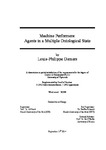Machine Performers: Agents in a Multiple Ontological State
| dc.contributor.supervisor | Scott, Jill | |
| dc.contributor.author | Demers, Louis-Philippe | |
| dc.contributor.other | Faculty of Arts, Humanities and Business | en_US |
| dc.date.accessioned | 2015-05-08T10:36:32Z | |
| dc.date.available | 2015-05-08T10:36:32Z | |
| dc.date.issued | 2015 | |
| dc.identifier | 374080 | en_US |
| dc.identifier.uri | http://hdl.handle.net/10026.1/3340 | |
| dc.description.abstract |
In this thesis, the author explores and develops new attributes for machine performers and merges the trans-disciplinary fields of the performing arts and artificial intelligence. The main aim is to redefine the term “embodiment” for robots on the stage and to demonstrate that this term requires broadening in various fields of research. This redefining has required a multifaceted theoretical analysis of embodiment in the field of artificial intelligence (e.g. the uncanny valley), as well as the construction of new robots for the stage by the author. It is hoped that these practical experimental examples will generate more research by others in similar fields. Even though the historical lineage of robotics is engraved with theatrical strategies and dramaturgy, further application of constructive principles from the performing arts and evidence from psychology and neurology can shift the perception of robotic agents both on stage and in other cultural environments. In this light, the relation between representation, movement and behaviour of bodies has been further explored to establish links between constructed bodies (as in artificial intelligence) and perceived bodies (as performers on the theatrical stage). In the course of this research, several practical works have been designed and built, and subsequently presented to live audiences and research communities. Audience reactions have been analysed with surveys and discussions. Interviews have also been conducted with choreographers, curators and scientists about the value of machine performers. The main conclusions from this study are that fakery and mystification can be used as persuasive elements to enhance agency. Morphologies can also be applied that tightly couple brain and sensorimotor actions and lead to a stronger stage presence. In fact, if this lack of presence is left out of human replicants, it causes an “uncanny” lack of agency. Furthermore, the addition of stage presence leads to stronger identification from audiences, even for bodies dissimilar to their own. The author demonstrates that audience reactions are enhanced by building these effects into machine body structures: rather than identification through mimicry, this causes them to have more unambiguously biological associations. Alongside these traits, atmospheres such as those created by a cast of machine performers tend to cause even more intensely visceral responses. In this thesis, “embodiment” has emerged as a paradigm shift – as well as within this shift – and morphological computing has been explored as a method to deepen this visceral immersion. Therefore, this dissertation considers and builds machine performers as “true” performers for the stage, rather than mere objects with an aura. Their singular and customized embodiment can enable the development of non-anthropocentric performances that encompass the abstract and conceptual patterns in motion and generate – as from human performers – empathy, identification and experiential reactions in live audiences. | en_US |
| dc.language.iso | en | en_US |
| dc.publisher | Plymouth University | en_US |
| dc.subject | Robotic art | en_US |
| dc.subject | Embodiment | |
| dc.subject | Performing arts | |
| dc.subject | Artificial intelligence | |
| dc.subject | Presence on the stage | |
| dc.subject | Agency | |
| dc.title | Machine Performers: Agents in a Multiple Ontological State | en_US |
| dc.type | Thesis | |
| plymouth.version | Edited version | en_US |
| dc.identifier.doi | http://dx.doi.org/10.24382/4620 |
Files in this item
This item appears in the following Collection(s)
-
01 Research Theses Main Collection
Research Theses Main


